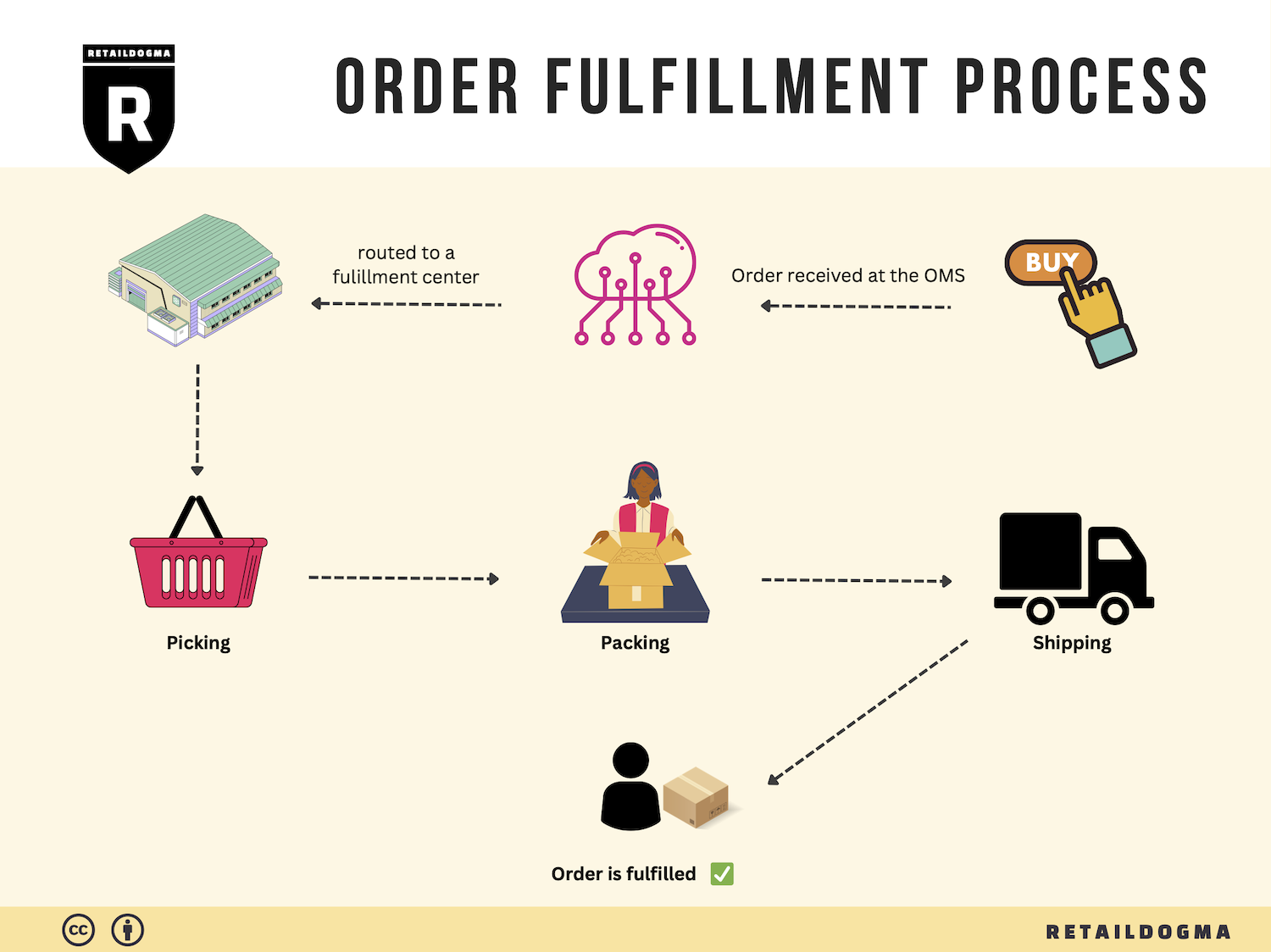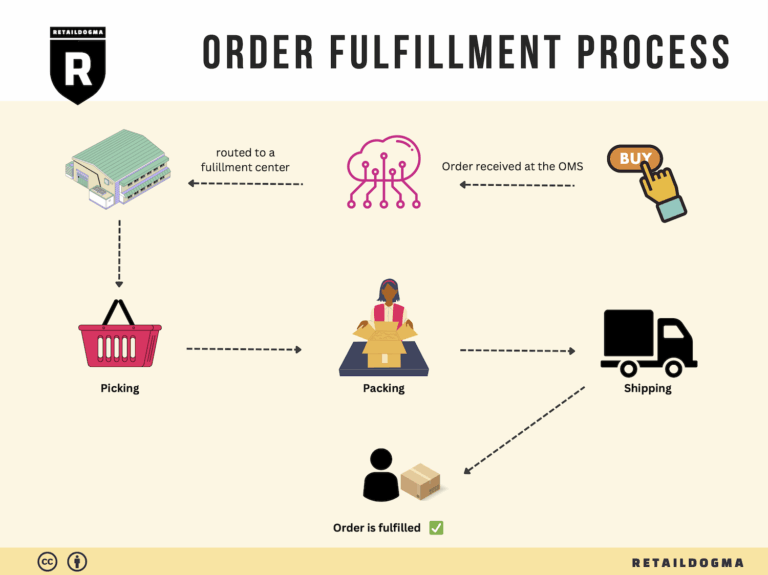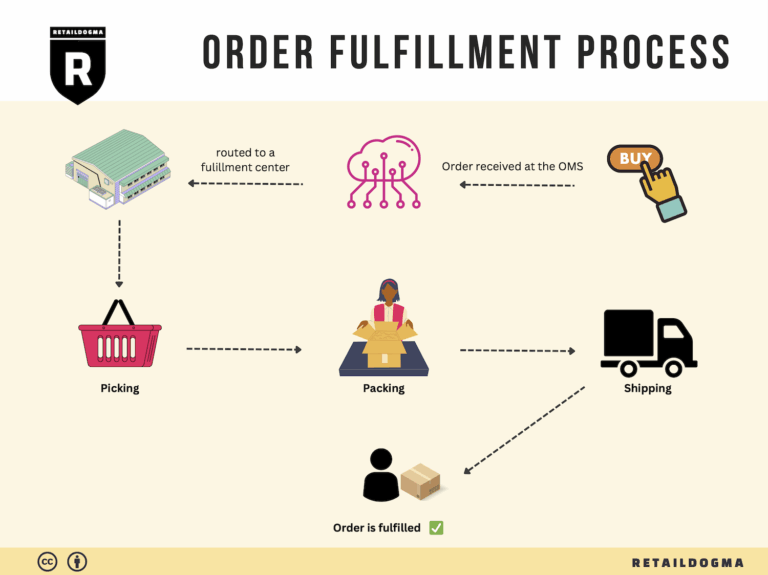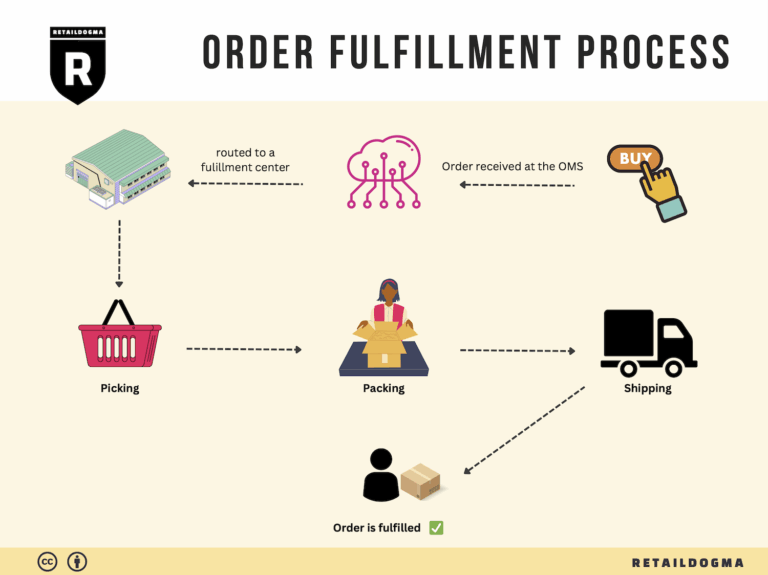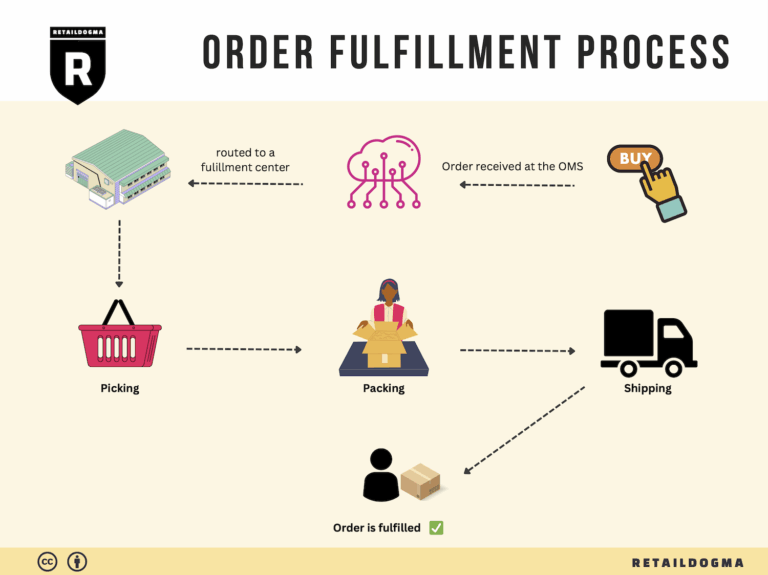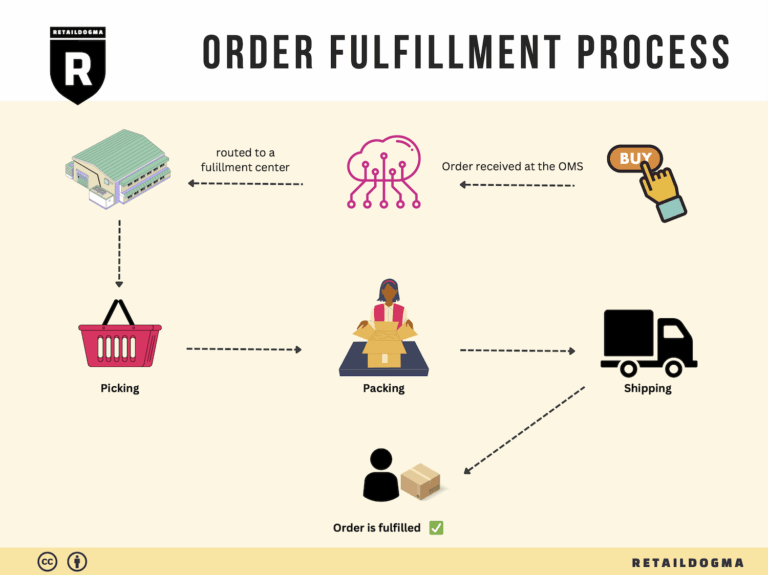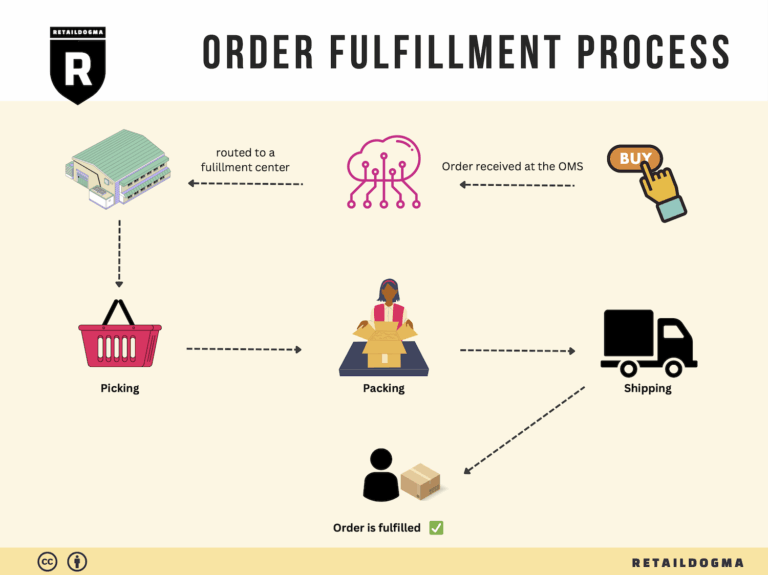How Order Fulfillment Works: A Step-by-Step Guide for Businesses
What is E-commerce Fulfillment? An Introduction for Growing Businesses
As your e-commerce business starts to grow, the excitement of increasing sales can quickly be overshadowed by the overwhelming logistics of packing and shipping orders. Managing inventory, ensuring timely deliveries, and maintaining customer satisfaction can feel like a juggling act, especially when you’re trying to scale. This is where understanding e-commerce fulfillment becomes essential.
Fulfillment, at its core, is the process of getting a product from your warehouse to your customer’s doorstep. It encompasses everything from inventory management and order processing to packing and shipping. However, as your order volume increases, handling these tasks in-house may become impractical. Many growing businesses find that outsourcing fulfillment can streamline operations, reduce costs, and enhance customer experiences.
In this guide, we will delve into the various fulfillment models available to e-commerce businesses. We’ll explore Third-Party Logistics (3PL) providers and Fulfillment by Amazon (FBA), among other options, so you can understand which model aligns best with your business needs. Each model has its advantages and challenges, and knowing these can help you make informed decisions.
We will also outline the core services typically offered by fulfillment partners, such as inventory storage, order processing, packaging, shipping, and returns management. Understanding these services will equip you to evaluate potential partners effectively.
Choosing the right fulfillment partner is a critical decision that can significantly impact your business. We’ll provide practical tips on what to look for in a partner, including their technology capabilities, shipping options, and customer service reputation.
Lastly, we’ll discuss pricing structures for fulfillment services, enabling you to budget accurately and assess the cost-effectiveness of various options.
The goal of this guide is to empower you with the knowledge to make smart logistics decisions as you scale your e-commerce operations. By understanding the intricacies of e-commerce fulfillment, you can focus on what you do best: growing your business and delighting your customers.
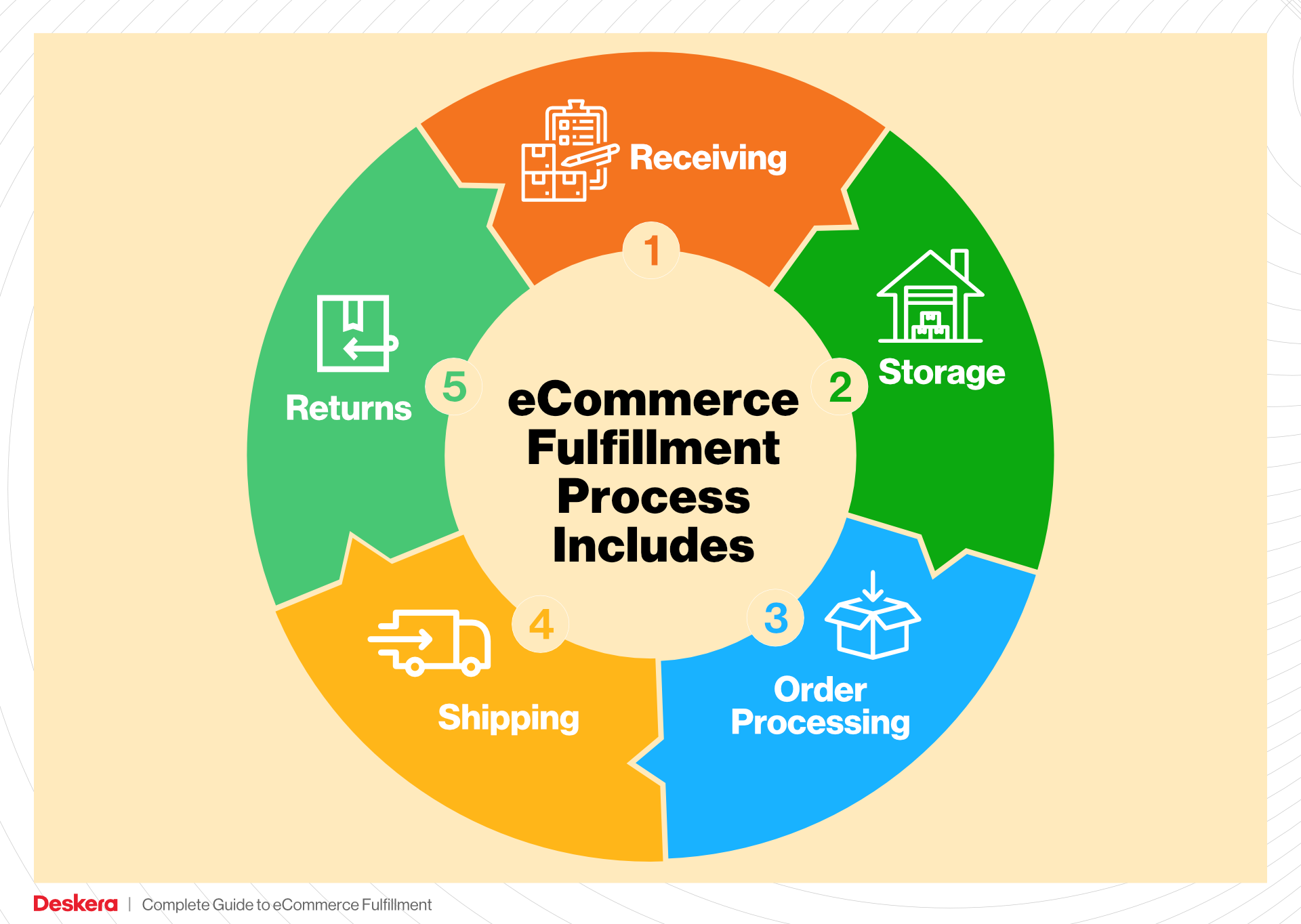
What You’ll Learn In This Guide
- What is E-commerce Fulfillment? An Introduction for Growing Businesses
- The Order Fulfillment Process: From ‘Buy’ Button to Customer’s Door
- Comparing Fulfillment Models: In-House vs. 3PL vs. Dropshipping
- A Deep Dive into Amazon FBA: Pros, Cons, and Who It’s For
- Core Services Offered by Fulfillment Centers
- How to Choose a Fulfillment Partner: A 6-Point Checklist
- Understanding Fulfillment Pricing: A Breakdown of Common Fees
- Frequently Asked Questions (FAQs) about Fulfillment
- Conclusion: Is Outsourcing Fulfillment the Right Move for Your Business?
- Important Disclaimer
The Order Fulfillment Process: From ‘Buy’ Button to Customer’s Door
1. Receiving Inventory
The order fulfillment process begins with receiving inventory, where products are delivered from suppliers to your warehouse. This step involves checking the shipment against purchase orders to ensure the correct quantity and quality of items have arrived. Key terms associated with this stage include SKU (Stock Keeping Unit), which helps identify and categorize products efficiently.
This step is crucial for maintaining accurate inventory levels and ensuring that your fulfillment operations can meet customer demand. If discrepancies arise—such as missing items or damaged goods—addressing them at this stage is vital to prevent further complications down the line. Effective inventory management software can aid in tracking these items, providing a clear picture of stock levels and helping businesses make informed purchasing decisions.
2. Warehouse Storage
Once the inventory is received and verified, the next step is warehouse storage. This involves organizing products in a way that maximizes space and accessibility. Efficient storage solutions often utilize bin locations or pallet racking systems to categorize items by size, type, or frequency of sales.
Proper storage is essential because it directly impacts the speed and efficiency of order fulfillment. A well-organized warehouse reduces the time spent locating products, thereby speeding up the order picking process. Businesses should also consider implementing inventory management systems that facilitate real-time tracking of stock levels, which can help prevent overstocking or stockouts.
3. Order Picking
Order picking is the process where warehouse staff select items from storage to fulfill a customer’s order. This step typically involves using pick lists, which are documents that outline the items and quantities to be collected for a specific order.
The importance of this stage cannot be overstated; accuracy in picking is critical to ensuring that customers receive the correct products. Mistakes during picking can lead to returns, exchanges, and decreased customer satisfaction. To enhance efficiency, many businesses are now adopting technologies such as barcode scanning or automated picking systems, which help streamline the picking process and reduce human error.
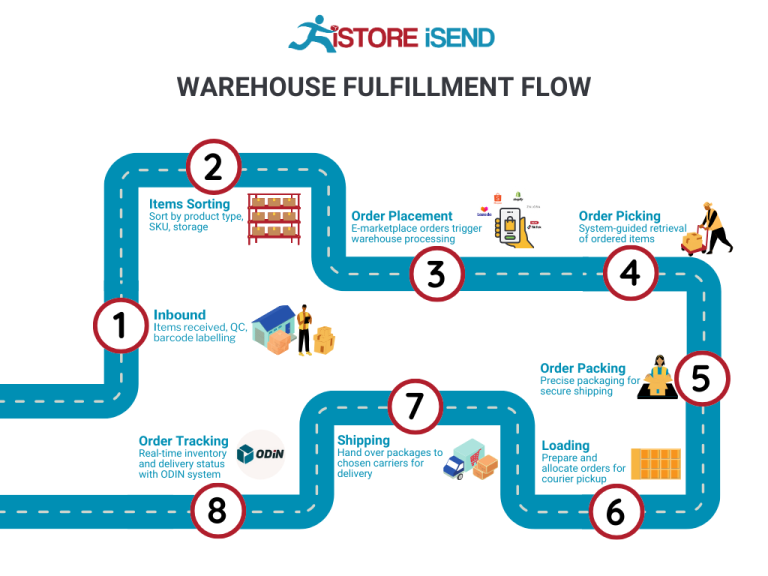
4. Order Packing
After items have been picked, they move on to the packing stage. Here, the selected products are carefully placed into packaging materials, ensuring they are secure and protected for transit. This step often involves using packing slips, which detail the contents of the shipment and provide important information for the customer.
Order packing is vital for minimizing damage during shipping and enhancing the customer experience. A well-packed order not only arrives in perfect condition but also reflects positively on your brand. Additionally, sustainable packing materials can help reduce your environmental footprint and appeal to eco-conscious consumers. Investing in efficient packing processes can lead to reduced shipping costs and improved overall fulfillment performance.
5. Shipping & Delivery
The final stage of the order fulfillment process is shipping and delivery. Once the order is packed and labeled, it is handed over to a shipping carrier. At this point, providing customers with tracking information is crucial. This allows them to monitor their order’s journey and enhances their overall experience.
Shipping and delivery are vital components of fulfillment that can significantly impact customer satisfaction. Timely delivery fosters trust and encourages repeat business, while delays can lead to frustration and lost sales. Businesses should evaluate shipping options regularly to ensure they are using the most efficient and cost-effective carriers. Furthermore, offering multiple shipping options can cater to various customer needs, enhancing their shopping experience.
In summary, the order fulfillment process is a complex but essential operation for e-commerce businesses. Each of the five steps—receiving inventory, warehouse storage, order picking, order packing, and shipping & delivery—plays a critical role in ensuring that customers receive their products on time and in good condition. By optimizing each stage, businesses can improve efficiency, reduce costs, and ultimately enhance customer satisfaction.
Comparing Fulfillment Models: In-House vs. 3PL vs. Dropshipping
Fulfillment Model Comparison
| Model | Who Handles Inventory | Best For (Business Stage) | Key Advantage | Key Disadvantage |
|---|---|---|---|---|
| In-House Fulfillment | Business (Owner) | Startups to Mid-Sized | Full control over inventory and operations | High overhead costs and resource allocation required |
| Third-Party Logistics (3PL) | 3PL Provider | Growing to Established | Scalable solutions and expertise in logistics | Less control over inventory and fulfillment process |
| Dropshipping | Supplier | Startups and Entrepreneurs | Low upfront investment and risk | Longer shipping times and potential quality issues |
In-House Fulfillment
In-house fulfillment is a model where a business manages its own inventory and order processing operations. This approach allows for complete control over every aspect of the fulfillment process, including inventory management, order processing, and shipping. Businesses that opt for in-house fulfillment can directly oversee quality control and customer service, fostering a personalized experience for their customers. This model is particularly suitable for startups to mid-sized businesses that have the resources to invest in warehousing and logistics infrastructure. The key advantage of in-house fulfillment is the ability to maintain high standards of quality and service, but it comes with significant overhead costs, including warehouse space, staffing, and technology investments. Additionally, as the business scales, managing logistics can become increasingly complex and resource-intensive.
Third-Party Logistics (3PL)
Third-party logistics (3PL) refers to outsourcing logistics and fulfillment processes to specialized providers. In this model, the 3PL provider handles inventory storage, order processing, packaging, and shipping on behalf of the business. This option is ideal for growing to established businesses that need scalable solutions without the burden of managing logistics in-house. One of the primary advantages of using a 3PL is access to their expertise and advanced technologies, which can streamline operations and reduce shipping costs. Moreover, 3PLs often have established networks and relationships with carriers, which can lead to faster delivery times. However, the key disadvantage is the loss of direct control over inventory and fulfillment processes, which can lead to potential misalignments in customer expectations if not managed properly. Businesses must ensure clear communication and integration with their 3PL to maintain a seamless customer experience.
Dropshipping
Dropshipping is a fulfillment model where a business sells products without holding inventory. Instead, when a customer places an order, the business purchases the item from a third-party supplier who then ships it directly to the customer. This model is particularly appealing to startups and entrepreneurs because it requires low upfront investment and minimal risk. Since there’s no need for warehousing, businesses can focus on marketing and customer acquisition rather than logistics. The primary advantage of dropshipping is the flexibility it offers, as businesses can easily test new products without significant financial commitment. However, dropshipping also has notable disadvantages, including longer shipping times and potential quality control issues. Since businesses rely on suppliers for fulfillment, any delays or discrepancies can reflect poorly on the business, impacting customer satisfaction. Additionally, profit margins can be slimmer due to the additional fees charged by suppliers, making it essential for entrepreneurs to carefully select reliable partners.
Conclusion
Choosing the right fulfillment model is crucial for e-commerce success and can significantly impact customer satisfaction and operational efficiency. In-house fulfillment provides control but at the cost of higher overhead, making it suitable for businesses ready to invest in logistics. Third-party logistics (3PL) offers a scalable solution for growing businesses but requires careful management of relationships and expectations. Dropshipping presents an accessible entry point for new entrepreneurs but comes with challenges related to quality and shipping times. Ultimately, the choice of fulfillment model should align with the business’s goals, resources, and customer expectations, allowing for a strategy that supports growth and enhances the customer experience.
A Deep Dive into Amazon FBA: Pros, Cons, and Who It’s For
Understanding Fulfillment by Amazon (FBA)
Fulfillment by Amazon (FBA) is a service offered by Amazon that enables e-commerce sellers to store their products in Amazon’s fulfillment centers. Amazon then takes care of storage, packaging, shipping, and customer service on behalf of the sellers. This allows businesses, particularly small to medium-sized enterprises, to leverage Amazon’s extensive logistics network and customer service capabilities.
How FBA Works
-
Product Listing: Sellers create product listings on Amazon and specify that they want to use FBA for order fulfillment.
-
Inventory Shipment: Sellers ship their products to Amazon’s fulfillment centers. Amazon provides shipping guidelines to ensure that products are delivered correctly.
-
Storage: Once received, Amazon stores the products in their warehouses. Sellers can track their inventory through the Amazon Seller Central dashboard.
-
Order Processing: When a customer places an order for a product, Amazon handles the entire fulfillment process. This includes picking the product from the warehouse, packing it, and shipping it directly to the customer.
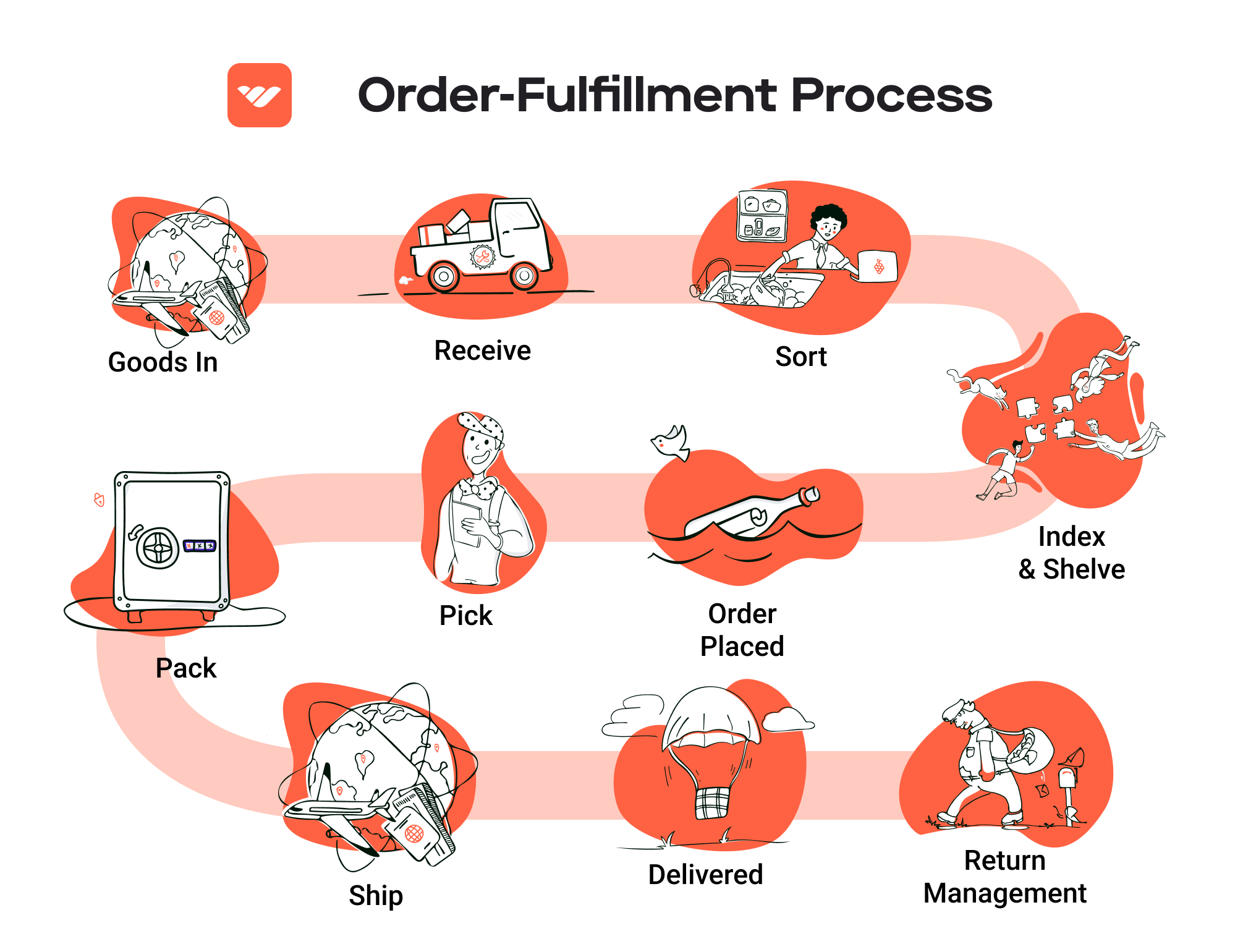
-
Customer Service: Amazon manages all aspects of customer service and returns for FBA orders. This includes answering customer inquiries and processing returns, ensuring a seamless experience for both sellers and buyers.
-
Payment: After a sale, Amazon collects the payment from the customer and transfers it to the seller, minus the FBA fees.
Pros of FBA
-
Prime Eligibility: One of the most significant advantages of using FBA is that products become eligible for Amazon Prime. This can significantly increase sales as Prime members often prioritize Prime-eligible products due to their faster shipping options.
-
Customer Trust: Leveraging Amazon’s brand can enhance customer trust. Buyers are more likely to purchase from sellers using FBA because they know that Amazon will handle the fulfillment process, ensuring reliability in shipping and customer service.
-
Multi-Channel Fulfillment: FBA isn’t limited to Amazon sales. Sellers can utilize FBA to fulfill orders from other platforms (like their own websites or eBay), allowing for a streamlined logistics process across multiple sales channels.
-
Scalability: FBA allows businesses to scale quickly without the need for significant investment in warehousing and logistics infrastructure. As sales grow, sellers can easily send more inventory to Amazon without worrying about the logistics of storage and shipping.
-
Time Savings: By outsourcing fulfillment to Amazon, sellers can focus more on marketing, product development, and customer engagement rather than logistics and order processing.
Cons of FBA
-
High Fees: While FBA offers many advantages, it comes at a cost. Sellers are responsible for various fees, including storage fees (which can increase during peak seasons) and fulfillment fees based on the size and weight of products. These fees can eat into profit margins, particularly for low-cost items.
-
Strict Inventory Rules: Amazon has stringent policies regarding inventory management. Sellers must adhere to specific guidelines regarding storage limits, labeling requirements, and product quality standards. Failing to comply can result in penalties or removal of listings.
-
Commingling Risks: FBA operates on a commingling model, meaning that products from different sellers can be stored together. This can lead to issues if a customer receives a product that does not match the seller’s quality or specifications, potentially harming the seller’s reputation.
-
Less Control Over Fulfillment: By using FBA, sellers relinquish control over the fulfillment process. This can be a disadvantage for brands that prioritize packaging, branding, and customer experience, as they may not have a say in how their products are handled.
-
Dependency on Amazon: Relying heavily on FBA can create a dependency on Amazon’s platform. Changes in Amazon’s policies, fees, or algorithms can significantly impact a seller’s business.
Who is FBA Best For?
Fulfillment by Amazon is particularly suited for:
-
Small to Medium-Sized Businesses: FBA allows smaller businesses to compete with larger retailers by providing access to Amazon’s logistics and customer service infrastructure.
-
Sellers with High Sales Volumes: Businesses that anticipate high sales volumes can benefit from FBA’s efficiency and scalability, allowing them to focus on growth without the burden of fulfillment logistics.
-
Brands Seeking Prime Access: Sellers looking to tap into the vast Prime customer base will find FBA invaluable as it enhances product visibility and increases the likelihood of sales.
-
E-commerce Entrepreneurs: New sellers who want to minimize upfront investment in warehousing and fulfillment can leverage FBA to enter the market more easily.
-
Multi-Channel Sellers: Businesses that sell across various platforms and want to streamline their fulfillment process will benefit from FBA’s multi-channel fulfillment capabilities.
In conclusion, while Fulfillment by Amazon provides a robust solution for many e-commerce businesses looking to scale, it is essential for sellers to carefully weigh the pros and cons against their specific business needs. Understanding the intricacies of FBA can help entrepreneurs make informed decisions that align with their growth strategies.
Core Services Offered by Fulfillment Centers
Inventory Management & Warehousing
Inventory management and warehousing are foundational services provided by fulfillment centers, crucial for maintaining the flow of goods in e-commerce operations. This service encompasses the storage, organization, and tracking of products within a warehouse environment. Fulfillment centers utilize advanced inventory management systems to ensure that stock levels are accurately monitored and updated in real-time.
Benefits:
1. Optimized Stock Levels: By efficiently managing inventory, fulfillment centers help prevent stockouts and overstock situations. This ensures that e-commerce businesses can meet customer demand without tying up excessive capital in unsold goods.
-
Space Efficiency: Warehousing solutions are designed to maximize storage space. By utilizing various storage methods (like pallet racking and shelving), businesses can store more products in a smaller footprint, reducing overhead costs.
-
Real-Time Visibility: Advanced inventory management systems provide e-commerce businesses with real-time data on stock levels, helping them make informed decisions regarding restocking and inventory turnover. This visibility is critical for scaling operations and maintaining customer satisfaction.
-
Reduced Operational Costs: Outsourcing inventory management to a fulfillment center reduces the need for businesses to invest in their own warehousing infrastructure and staffing, leading to significant cost savings.
Pick and Pack Services
Pick and pack services are essential processes in the order fulfillment journey, where items are selected from inventory (picked) and then packaged for shipment (packed). Fulfillment centers employ trained staff and automated systems to efficiently handle this process, ensuring that orders are filled accurately and swiftly.
Benefits:
1. Increased Efficiency: Fulfillment centers are designed for high-volume order processing. Their systems streamline the picking and packing process, reducing the time it takes to fulfill orders and improving overall operational efficiency.
-
Accuracy and Quality Control: With rigorous quality control measures in place, fulfillment centers minimize errors in order fulfillment. This leads to higher customer satisfaction rates, as customers receive exactly what they ordered without discrepancies.
-
Scalability: As e-commerce businesses grow, their order volumes may fluctuate. Fulfillment centers can easily scale their pick and pack services to accommodate spikes in demand, ensuring that businesses can meet customer expectations without compromising service quality.
-
Customized Packaging Solutions: Many fulfillment centers offer customized packaging options that enhance brand identity while also ensuring that products are well-protected during transit. This attention to detail can significantly enhance the customer experience.
Kitting and Assembly
Kitting and assembly services refer to the process of grouping individual items together to create a single product or kit, which can include assembling components into a final product. This service is particularly beneficial for e-commerce businesses that sell products that require assembly or have multiple components.
Benefits:
1. Streamlined Operations: By outsourcing kitting and assembly, e-commerce businesses can streamline their production processes. Fulfillment centers specialize in efficient assembly, allowing businesses to focus on other core activities such as marketing and sales.
-
Cost Reduction: Kitting and assembly can reduce shipping costs by consolidating multiple items into a single package. This not only lowers shipping fees but also simplifies inventory management, as businesses can track kits as single SKUs.
-
Enhanced Customer Experience: Offering pre-assembled kits can improve the customer experience, as buyers receive ready-to-use products that save them time and effort. This convenience can lead to increased sales and customer loyalty.
-
Flexibility: Fulfillment centers can quickly adapt to changes in product offerings or kit configurations, enabling e-commerce businesses to respond to market trends or customer preferences without significant delays.
Returns Management (Reverse Logistics)
Returns management, or reverse logistics, is a critical service offered by fulfillment centers that deals with the process of handling returned items. This includes the inspection, restocking, and potentially refurbishing of returned products. Efficient returns management is vital for maintaining customer trust and satisfaction.
Benefits:
1. Customer Retention: A seamless return process can significantly enhance customer satisfaction and loyalty. When customers know they can easily return products, they are more likely to make purchases, knowing their investment is protected.
-
Operational Efficiency: Fulfillment centers are equipped to handle returns efficiently, ensuring that returned items are processed quickly and accurately. This minimizes the time products spend out of inventory, allowing businesses to resell items faster.
-
Data Insights: Returns management provides valuable data on customer behavior and product performance. Understanding why products are returned can help e-commerce businesses make informed decisions about product quality, descriptions, and marketing strategies.
-
Cost Control: By effectively managing returns, fulfillment centers help e-commerce businesses reduce losses associated with returned items. This includes minimizing restocking costs and optimizing inventory levels based on return trends.
In conclusion, leveraging the core services offered by fulfillment centers can significantly enhance the operational efficiency and scalability of e-commerce businesses. By outsourcing these processes, businesses can focus on growth and customer satisfaction while ensuring that their logistics are handled by experts in the field.
How to Choose a Fulfillment Partner: A 6-Point Checklist
Location & Warehouse Network
Importance: The geographical location of your fulfillment partner’s warehouses can significantly impact shipping times and costs. A partner with strategically located facilities can enable faster deliveries, reducing transit times and enhancing customer satisfaction.
Questions to Ask:
1. Where are your warehouses located, and how does this align with our customer base?
2. Do you have multiple facilities to optimize shipping routes?
3. How do you manage inventory across different locations to ensure timely fulfillment?
Technology & Integrations
Importance: A robust technology stack is essential for seamless operations. Your fulfillment partner should offer integrations with your e-commerce platform, inventory management systems, and any other tools you use to manage your business.
Questions to Ask:
1. What technology do you use to manage orders and inventory?
2. Can you integrate with our existing systems (e.g., Shopify, WooCommerce, etc.)?
3. Do you provide real-time tracking and reporting capabilities?
4. How do you handle updates to our inventory levels?
Specializations (e.g., Cold Storage, Oversized Items)
Importance: Depending on your product offerings, it may be crucial to partner with a fulfillment center that specializes in certain types of products. For example, if you sell perishable goods, a partner with cold storage capabilities will be necessary.
Questions to Ask:
1. What types of products do you specialize in fulfilling?
2. Do you have the facilities to handle specific requirements, such as temperature control or oversized items?
3. Can you accommodate unique packaging needs for our products?
Scalability & Capacity
Importance: As your business grows, your fulfillment needs will change. Selecting a partner that can scale with your business ensures that you won’t have to switch providers as order volumes increase.
Questions to Ask:
1. How do you handle increased order volumes during peak seasons?
2. What are your capacity limits, and how can you accommodate growth?
3. Do you have a plan in place for scaling operations, such as hiring additional staff or expanding warehouse space?
Pricing and Contracts
Importance: Understanding the pricing structure and contract terms is vital for budgeting and ensuring there are no hidden costs. Transparent pricing helps you maintain profit margins while offering competitive shipping rates to customers.
Questions to Ask:
1. What is your pricing model (e.g., per order, per item, storage fees)?
2. Are there any additional fees we should be aware of (e.g., for returns, packaging, or special handling)?
3. What are the terms of the contract, and is there flexibility for renegotiation as our needs change?
4. How do you handle pricing adjustments due to market changes?
Customer Support & Reviews
Importance: Reliable customer support is essential for resolving issues quickly and maintaining smooth operations. Additionally, checking reviews and testimonials from other clients can provide insights into the partner’s reliability and service quality.
Questions to Ask:
1. What level of customer support do you offer (e.g., dedicated account manager, 24/7 support)?
2. How do you handle issues such as lost shipments or inventory discrepancies?
3. Can you provide references or case studies from businesses similar to ours?
4. What feedback mechanisms do you have in place for ongoing improvement?
By evaluating potential fulfillment partners against this checklist, you can make an informed decision that aligns with your business goals and enhances your operational efficiency. A strategic partnership in fulfillment can not only streamline your logistics but also significantly improve customer satisfaction, setting the stage for sustained growth in your e-commerce business.
Understanding Fulfillment Pricing: A Breakdown of Common Fees
Initial Setup Fees
When partnering with a fulfillment provider, one of the first costs you may encounter is the initial setup fee. This fee is typically charged to cover the administrative work involved in onboarding your business. It often includes setting up your account, integrating your e-commerce platform with their system, and establishing the necessary protocols for managing your inventory and orders.
Calculation: Initial setup fees can vary significantly among providers, ranging from a few hundred to several thousand dollars. The total is often influenced by the complexity of your operations, the number of products you sell, and the level of customization required for your account setup. It’s essential to clarify what specific services are included in this fee to avoid any unexpected costs.
Receiving Fees
Once your products arrive at the fulfillment center, receiving fees come into play. These fees cover the labor involved in unloading, inspecting, and storing your inventory. The process ensures that items are correctly accounted for and ready for future orders.
Calculation: Receiving fees are typically charged per pallet or per unit. For example, a fulfillment center might charge a flat fee of $20 per pallet or $0.50 per item received. Additional charges may apply for special handling, such as if your items require additional inspection or sorting upon arrival. Understanding these fees upfront can help you budget effectively for your incoming inventory.
Storage Fees (per pallet/bin)
Storage fees are ongoing costs associated with keeping your inventory at the fulfillment center. These fees ensure that your products are stored safely and are readily accessible for order fulfillment. Storage costs can vary based on the size of your inventory and the duration it remains in the warehouse.
Calculation: Storage fees are generally calculated on a monthly basis, charged either per pallet or per bin. For instance, you might encounter fees of $15 per pallet per month or $5 per bin. Some providers may offer tiered pricing, where the rate decreases as you store larger quantities. Be aware of any minimum storage fees or limits on how long products can be stored before incurring additional charges.
Pick & Pack Fees (per item/order)
Pick and pack fees are charged for the labor involved in selecting items from your inventory and packaging them for shipment. This is a crucial stage in the fulfillment process, as it directly impacts order accuracy and customer satisfaction.
Calculation: These fees are typically assessed per item or per order. For example, you might see charges of $1.00 per item picked and packed or a flat fee of $2.50 per order, regardless of the number of items included. Some fulfillment centers may also have tiered pricing based on order volume, where costs decrease as you fulfill more orders. It’s vital to understand how these fees are structured, especially if you anticipate fluctuations in order volume.
Shipping Fees
Shipping fees are one of the most significant costs in the fulfillment process, representing the expense of delivering products from the fulfillment center to your customers. These fees can vary based on several factors, including the shipping method, destination, package weight, and dimensions.
Calculation: Shipping fees are often calculated using a combination of factors, including the carrier rates (e.g., USPS, FedEx, UPS), the service level (standard, expedited, overnight), and any additional services like insurance or tracking. Many fulfillment centers offer discounted shipping rates due to their volume, which can benefit your overall costs. It’s essential to compare shipping options and be aware of any surcharges that may apply for remote locations or oversized packages.
Tips for Getting an Accurate Quote
When seeking quotes for fulfillment services, consider the following tips to ensure you receive a comprehensive and accurate estimate:
-
Provide Detailed Information: Clearly outline your business needs, including the types of products you sell, average order volume, and any special handling requirements. The more information you provide, the more tailored the quote will be.
-
Ask About Hidden Fees: Inquire about any additional fees that may not be included in the initial quote, such as returns processing, inventory management, or seasonal surcharges.
-
Request a Breakdown of Costs: A detailed breakdown of fees will help you understand where your money is going and allow you to compare different providers more effectively.
-
Consider Long-Term Contracts: Some fulfillment centers offer discounts for long-term commitments. If you anticipate growth, this could lead to significant savings over time.
-
Evaluate Scalability: As your business grows, your fulfillment needs will likely change. Ensure that the provider can accommodate your future requirements without incurring exorbitant costs.
By understanding these common fulfillment pricing models and following these tips, you can make informed decisions that align with your business goals and budget.
Frequently Asked Questions (FAQs) about Fulfillment
1. What is fulfillment status?
Fulfillment status refers to the current stage of an order in the fulfillment process, which includes various phases such as unfulfilled, partially fulfilled, fulfilled, and shipped. Understanding this status helps businesses manage customer expectations, optimize operations, and ensure timely deliveries.
2. How does fulfillment status differ from order status?
Fulfillment status specifically tracks the actions related to preparing and shipping products, while order status indicates the overall progress of the order from placement to delivery. For example, fulfillment status includes stages like picked, packed, and shipped, whereas order status includes pending, processing, and delivered.
3. What are the key stages of fulfillment status?
The key stages of fulfillment status include:
– Unfulfilled: Order received but not yet processed.
– Partially Fulfilled: Some items shipped; others pending.
– Fulfilled: All items processed and delivered.
– On Hold: Processing paused due to issues.
– Scheduled: Fulfillment planned for a specific date.
– Picked: Items located and ready for packing.
– Packed: Items securely packaged for shipping.
– Shipped: Order dispatched and on its way to the customer.
4. What is a 3PL, and how does it relate to fulfillment?
A 3PL (Third-Party Logistics) provider offers logistics services including warehousing, inventory management, and order fulfillment. Businesses often partner with 3PLs to streamline their fulfillment processes, reduce operational costs, and improve efficiency, allowing them to focus on core business activities.
5. How much do fulfillment services cost?
Fulfillment service costs vary widely based on factors such as order volume, storage needs, shipping methods, and additional services (like packaging). Typically, businesses can expect to pay a combination of storage fees, pick-and-pack fees, and shipping costs. It’s essential to request quotes from multiple providers to find a solution that fits your budget.
6. Why is tracking fulfillment status important for e-commerce businesses?
Tracking fulfillment status is crucial for managing customer expectations and providing timely updates on order progress. It helps identify bottlenecks, improves inventory management, and enhances overall customer satisfaction by ensuring transparency throughout the order process.
7. What should I do if an order is stuck in a fulfillment stage?
If an order is stuck in a specific fulfillment stage, first check for any alerts or notifications regarding issues (e.g., payment verification, inventory shortages). Communicate with your fulfillment provider to identify the problem and resolve it quickly. Keeping the customer informed about the situation can help maintain trust.
8. How can I improve my fulfillment process?
To improve your fulfillment process, consider the following strategies:
– Automate Order Management: Use software to track orders and manage inventory in real-time.
– Optimize Inventory Levels: Maintain appropriate stock levels to reduce unfulfilled orders.
– Outsource Fulfillment: Partner with a reliable 3PL to leverage their expertise and resources.
– Enhance Communication: Provide clear updates to customers regarding their order status to improve satisfaction.
9. What technologies can help with tracking fulfillment status?
Several technologies can aid in tracking fulfillment status, including:
– Inventory Management Systems: To monitor stock levels and order processing.
– Order Management Systems (OMS): For real-time tracking of order status and fulfillment stages.
– Barcode Scanning: To streamline picking and packing processes.
– Shipping Software: For tracking shipments and providing customers with updates.
10. How do I choose the right fulfillment provider for my business?
When choosing a fulfillment provider, consider the following criteria:
– Service Offerings: Ensure they meet your specific logistics needs (e.g., storage, shipping).
– Technology Integration: Check for compatibility with your existing systems.
– Cost Structure: Understand their pricing model and any hidden fees.
– Scalability: Assess their ability to grow with your business.
– Customer Service: Look for providers with strong support and communication channels.
Conclusion: Is Outsourcing Fulfillment the Right Move for Your Business?
Evaluating the Benefits of Outsourcing Fulfillment
Outsourcing your fulfillment process can be a transformative decision for your e-commerce business, offering numerous advantages that can significantly enhance your operational efficiency and customer satisfaction. One of the most compelling benefits is time savings. By partnering with a dedicated fulfillment service, you can redirect your focus away from logistical challenges and concentrate on core business activities such as product development, marketing, and customer engagement. This shift not only improves productivity but also allows for more strategic growth initiatives.
Scalability is another critical benefit of outsourcing fulfillment. As your business grows, so do your order volumes and the complexities associated with handling them. A proficient fulfillment partner has the infrastructure and expertise to scale operations seamlessly, ensuring that you can meet customer demands without compromising service quality. This flexibility is particularly vital during peak seasons or promotional campaigns, where demand can surge unexpectedly.
Moreover, leveraging the expertise of a fulfillment partner can provide insights and efficiencies that you may not achieve in-house. These partners often have established networks, advanced technology, and industry knowledge that can optimize your logistics processes, reduce costs, and enhance delivery speed. Choosing the right fulfillment partner is crucial; it should align with your business goals, operational needs, and customer expectations to foster sustainable growth.
As you evaluate your options, consider conducting a thorough audit of your current shipping and fulfillment processes. This assessment will help you identify inefficiencies and determine whether partnering with a fulfillment service could be the right strategic move for your business. Taking this step could unlock new opportunities for growth and customer satisfaction, positioning your brand for long-term success in the competitive e-commerce landscape.
Important Disclaimer
⚠️ Important Disclaimer
The information in this guide is for educational purposes. Fulfillment services, pricing, and platform features change frequently. Always conduct your own due diligence and consult with providers directly before making business decisions.
